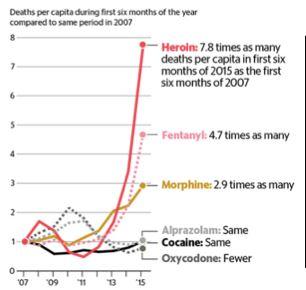The US has been in the grips of an “opioid epidemic” since the 1990s, with massive rises in the use – and misuse – of opioids such as morphine and codeine. There has also been a parallel rise in the number of opioid-related deaths, from 8,048 in 1999 to 42,249 in 2016. Now, there are signs that the problem is spreading to other nations – including the UK.
The current epidemic in the US is thought to have begun with the over-prescription of opioids for pain relief: in 1991, 76m opioid prescriptions were dispensed by US retail pharmacies. By 2011, this figure was 219m. The overall rate of death from drug overdose more than trebled in the US between 1999 and 2016.
In 2017, President Trump officially declared the US epidemic a public health emergency, establishing a presidential commission to combat the crisis and introducing the death penalty for drug traffickers.
The US has 5% of the world’s population and 80% of the world’s opioid use. But there is growing evidence that the rest of the world is following suit. Researchers found that in the 10-year period to 2013, the number of opioid doses prescribed in the US rose from 16,046 to 31,453 per million people per day, while in Western and Central Europe it rose from 3,079 to 9,320. Germany had the closest rates to those in the US (23,352 doses per million people per day), while in the UK doses rose from 1,658 to 5,227 per million people per day.
Prescriptions on the rise
With colleagues from Scottish universities, we published research exploring the factors associated with the rates of opioid prescribing in Scotland. We looked at a record of every prescription for opioid medicine dispensed in Scotland between 2003 and 2012. The trend we uncovered was startling.
We found that the number of prescriptions of “strong” opioids (including morphine, fentanyl, oxycodone and others) more than doubled from 474,385 to 1,036,446 per year. A full 18% of people in Scotland received at least one opioid prescription in 2012.
Women were more likely to receive a “weak” opioid (such as codeine or tramadol), but there was no gender difference in the prescription of strong opioids. There were also clear social divisions in opioid prescriptions: prescribing rates rose with age, and there were four times more prescriptions for strong opioids dispensed to people in the most deprived areas, than to those in the most affluent areas.

Down and out. Shutterstock.
Geography was also important, as prescribing rates differed between regions. This pattern was partly – though not wholly – associated with areas of relative deprivation. A recent study in England also found geographical variation in opioid prescribing rates, with a clear north-south divide, and London having the lowest rates.
It’s also worth noting that although the rates of opioid prescribing in Scotland are following the upward trends seen elsewhere, most of the prescribing seems to be appropriate. We found that it was related to the presence and severity of pain, and there remain many people who have significant pain but have not received an opioid.
Can opioids work?
There’s good evidence to suggest that opioids are effective at relieving pain in the short term. But few studies have gauged their benefits for more than 12 weeks’ treatment – despite the high numbers of patients who take them for many months and years. By contrast, there is clear evidence that they cause widespread and potentially serious harms, when taken long term.
Common side effects include constipation and sedation, but opioids can also have a bad impact on the respiratory, central nervous, cardiovascular, endocrine and immune systems. Whether opioids are used illicitly for recreation, or taken legitimately for pain, they can lead to misuse, addiction and – as demonstrated in the US – death.
In our other recent study, we found through systematic analysis of previous research that 4.7% of people who were prescribed opioids for pain went on to develop formally diagnosed misuse or addiction. It’s possible that more cases went undiagnosed.
Perhaps counter-intuitively, longer-term opioid exposure, and prescription of strong rather than weak opioids, were associated with lower incidences of opioid dependence or abuse. Individual factors, such as depression, anxiety and previous substance misuse, increase the risk of addiction. It is possible to use validated screening questionnaires to detect people who are at high risk of addiction before treatment is started.
Given the harms to individuals and societies, it’s fair to ask whether we should be prescribing opioids at all. The answer to this is definitely “yes” – for short-term pain, and with caution. For long-term pain, it’s essential to recognise the risk of developing side effects while not necessarily easing pain. Prescribed appropriately, however, opioids can make life better for people experiencing pain.
Clear guidelines for doctors and screening processes could help reduce the harm caused by opioids. But we must also address the causes of long-term pain, which drives their use. Most importantly, these include deprivation, and the ageing demography of our society. Without investment to address these, the opioid epidemic is set to spread globally.
By Blair H. Smith, Head of Population Health Sciences Division, Professor of Population Science, University of Dundee. He receives funding from European Commission (Horizon 2020) for research into neuropathic pain. He has recently received research funding from other organizations including the Medical Research Council, the Chief Scientist Office (Scottish Government) and Tenovus Scotland. He is National Lead Clinician for Scotland, and a member of the Scottish National Advisory Committee on Chronic Pain. He is a member of the Scottish National Party. This article was originally published on The Conversation. Read the original article.



